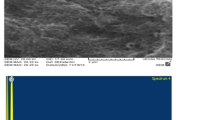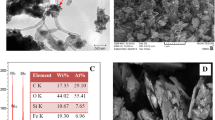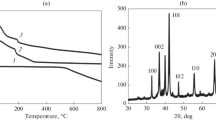Abstract
The present work addresses the electrochemical detection of an anthelmintic drug mebendazole (MBZ) using glassy carbon electrode (GCE) modified with the hybrid nanocomposites of poly(o-anisidine) (POA) and multi-walled carbon nanotubes (CNTs). The POA/CNTs (PC) nanocomposites were synthesized with different concentrations of o-anisidine via chemical oxidative polymerization route. The formation of nanocomposites were characterized by field emission scanning electron microscopy (FESEM), high resolution transmission electron microscopy (HRTEM), Fourier transform infrared spectroscopy (FTIR) and Raman spectroscopy studies. The morphological analysis revealed a matrix transition on varying the o-anisidine concentration in the composites. The appropriate selection of polymer and the composite enabled the design of nanostructures with highly tunable charge transport properties. FTIR and Raman studies proposed the existence of interfacial interaction between POA and CNTs which enhanced the sensing efficiency. The electrochemical performance of MBZ on the modified electrode has been examined using cyclic voltammetry, differential pulse voltammetry and chronoamperometry techniques. The best composite ratio for effective determination of MBZ, the oxidation–reduction properties and the electrochemical parameters governing the performance of the modified electrodes were studied by electrochemical approaches. Under the optimized conditions, the oxidation peak current presented a linear relationship with the MBZ concentration in the range from 1.0 to 35.0 µM with a detection limit of 0.4 μM (S/N = 3) by DPV method. The modified electrode was also used for the determination of MBZ in pharmaceutical samples. With the advantages of simplicity and high sensitivity, the fabricated sensor would provide a promising platform for the detection of other such anthelmintic drugs.
Graphical abstract














Similar content being viewed by others
References
Caira MR, Dekker TG, Liebenberg W (1998) Structure of a 1:1 complex between the anthelmintic drug mebendazole and propionic acid. J Chem Crystallogr 28(1):11–15. doi:10.1023/a:1021766300133
Swanepoel E, Liebenberg W, de Villiers MM (2003) Quality evaluation of generic drugs by dissolution test: changing the USP dissolution medium to distinguish between active and non-active mebendazole polymorphs. Eur J Pharm Biopharm 55(3):345–349. doi:10.1016/S0939-6411(03)00004-3
de Silva NR, Brooker S, Hotez PJ, Montresor A, Engels D, Savioli L (2003) Soil-transmitted helminth infections: updating the global picture. Trends Parasitol 19(12):547–551. doi:10.1016/j.pt.2003.10.002
Brooker S, Clements ACA, Bundy DAP (2006) Global epidemiology, ecology and control of soil-transmitted helminth infections. Adv Parasitol 62:221–261. doi:10.1016/s0065-308x(05)62007-6
Brooker S (2010) Estimating the global distribution and disease burden of intestinal nematode infections: adding up the numbers—a review. Int J Parasitol 40(10):1137–1144. doi:10.1016/j.ijpara.2010.04.004
Dayan AD (2003) Albendazole, mebendazole and praziquantel. Review of non-clinical toxicity and pharmacokinetics. Acta Trop 86(2):141–159. doi:10.1016/S0001-706X(03)00031-7
Münst GJ, Karlaganis G, Bircher J (1980) Plasma concentrations of mebendazole during treatment of echinococcosis. Eur J Clin Pharmacol 17(5):375–378. doi:10.1007/bf00558451
Crompton DWT et al. (2003) Controlling disease due to helminth infections. World Health Organization, Geneva.http://nla.gov.au/nla.cat-vn3109618. Accessed 1 Jan 2004
Kar A (1985) Spectrophotometric determination of mebendazole in pure and dosage forms by complexation with potassium bismuth(III) iodide. Analyst 110(8):1031–1033. doi:10.1039/an9851001031
Argekar AP, Raj SV, Kapadia SU (1997) Simultaneous determination of mebendazole and pyrantel pamoate from tablets by high performance liquid chromatography-reverse phase (RP-HPLC). Talanta 44(11):1959–1965. doi:10.1016/S0039-9140(96)02118-2
Facino RM, Carini M, Traldi P (1992) Application of collisionally activated decomposition mass-analysed ion kinetic energy spectrometry to a survey of sheep milk for benzimidazole residues in relation to withdrawal periods. Biol Mass Spectrom 21(4):195–201. doi:10.1002/bms.1200210404
Balizs G (1999) Determination of benzimidazole residues using liquid chromatography and tandem mass spectrometry. J Chromatogr B Biomed Sci Appl 727(1):167–177. doi:10.1016/S0378-4347(99)00052-3
Ghalkhani M, Shahrokhian S (2013) Adsorptive stripping differential pulse voltammetric determination of mebendazole at a graphene nanosheets and carbon nanospheres/chitosan modified glassy carbon electrode. Sens Actuators B Chem 185:669–674. doi:10.1016/j.snb.2013.05.054
Munusamy S, Suresh R, Giribabu K, Manigandan R, Praveen Kumar S, Muthamizh S, Bagavath C, Stephen A, Kumar J, Narayanan V (2015) Synthesis and characterization of GaN/PEDOT–PPY nanocomposites and its photocatalytic activity and electrochemical detection of mebendazole. Arab J Chem. doi:10.1016/j.arabjc.2015.10.012
Khan R, Solanki PR, Kaushik A, Singh SP, Ahmad S, Malhotra BD (2009) Cholesterol biosensor based on electrochemically prepared polyaniline conducting polymer film in presence of a nonionic surfactant. J Polym Res 16(4):363–373. doi:10.1007/s10965-008-9237-8
Satheesh Babu TG, Varadarajan D, Murugan G, Ramachandran T, Nair BG (2012) Gold nanoparticle–polypyrrole composite modified TiO2 nanotube array electrode for the amperometric sensing of ascorbic acid. J Appl Electrochem 42(6):427–434. doi:10.1007/s10800-012-0416-2
Palod PA, Pandey SS, Hayase S, Singh V (2014) Template-assisted electrochemical growth of polypyrrole nanotubes for development of high sensitivity glucose biosensor. Appl Biochem Biotechnol 174(3):1059–1072. doi:10.1007/s12010-014-0988-x
Zhou D-M, Dai Y-Q, Shiu K-K (2010) Poly(phenylenediamine) film for the construction of glucose biosensors based on platinized glassy carbon electrode. J Appl Electrochem 40(11):1997–2003. doi:10.1007/s10800-010-0179-6
Zhang L, Wen Y, Yao Y, Xu J, Duan X, Zhang G (2014) Synthesis and characterization of PEDOT Derivative with carboxyl group and its chemo/bio sensing application as nanocomposite, immobilized biological and enhanced optical materials. Electrochim Acta 116:343–354. doi:10.1016/j.electacta.2013.11.042
Du D, Cai J, Song D, Zhang A (2007) Rapid determination of triazophos using acetylcholinesterase biosensor based on sol–gel interface assembling multiwall carbon nanotubes. J Appl Electrochem 37(8):893–898. doi:10.1007/s10800-007-9328-y
Radoi A, Obreja AC, Eremia SAV, Bragaru A, Dinescu A, Radu GL (2013) l-Lactic acid biosensor based on multi-layered graphene. J Appl Electrochem 43(10):985–994. doi:10.1007/s10800-013-0594-6
Dong X, Ma Y, Zhu G, Huang Y, Wang J, Chan-Park MB, Wang L, Huang W, Chen P (2012) Synthesis of graphene-carbon nanotube hybrid foam and its use as a novel three-dimensional electrode for electrochemical sensing. J Mater Chem 22(33):17044–17048. doi:10.1039/c2jm33286h
Zhou S, Li J, Zhang F, Zhang T, Huang H, Song W (2015) Dispersible mesoporous carbon nanospheres as active electrode materials for biomolecular sensing. Microporous Mesoporous Mater 202:73–79. doi:10.1016/j.micromeso.2014.09.052
Lawal AT (2016) Synthesis and utilization of carbon nanotubes for fabrication of electrochemical biosensors. Mater Res Bull 73:308–350. doi:10.1016/j.materresbull.2015.08.037
Feng X, Yan Z, Li R, Liu X, Hou W (2013) The synthesis of shape-controlled polypyrrole/graphene and the study of its capacitance properties. Polym Bull 70(8):2291–2304. doi:10.1007/s00289-013-0952-x
Sun W, Mo Z (2014) Synthesis, characterization and supercapacitors of electrically conductive PPy/graphene/rare earth ions composites. Polym Bull 71(9):2173–2184. doi:10.1007/s00289-014-1177-3
Teixeira SR, Lloyd C, Yao S, Andrea Salvatore G, Whitaker IS, Francis L, Conlan RS, Azzopardi E (2016) Polyaniline-graphene based α-amylase biosensor with a linear dynamic range in excess of 6 orders of magnitude. Biosens Bioelectron 85:395–402. doi:10.1016/j.bios.2016.05.034
Radhapyari K, Kotoky P, Das MR, Khan R (2013) Graphene–polyaniline nanocomposite based biosensor for detection of antimalarial drug artesunate in pharmaceutical formulation and biological fluids. Talanta 111:47–53. doi:10.1016/j.talanta.2013.03.020
Kulkarni MV, Kale BB (2013) Studies of conducting polyaniline (PANI) wrapped-multiwalled carbon nanotubes (MWCNTs) nanocomposite and its application for optical pH sensing. Sens Actuators B Chem 187:407–412. doi:10.1016/j.snb.2012.12.106
Bo Y, Yang H, Hu Y, Yao T, Huang S (2011) A novel electrochemical DNA biosensor based on graphene and polyaniline nanowires. Electrochim Acta 56(6):2676–2681. doi:10.1016/j.electacta.2010.12.034
Feng X, Cheng H, Pan Y, Zheng H (2015) Development of glucose biosensors based on nanostructured graphene-conducting polyaniline composite. Biosens Bioelectron 70:411–417. doi:10.1016/j.bios.2015.03.046
Abdulla S, Mathew TL, Pullithadathil B (2015) Highly sensitive, room temperature gas sensor based on polyaniline-multiwalled carbon nanotubes (PANI/MWCNTs) nanocomposite for trace-level ammonia detection. Sens Actuators B Chem 221:1523–1534. doi:10.1016/j.snb.2015.08.002
Zou Y, Sun L-X, Xu F (2007) Biosensor based on polyaniline–Prussian Blue/multi-walled carbon nanotubes hybrid composites. Biosens Bioelectron 22(11):2669–2674. doi:10.1016/j.bios.2006.10.035
Fang Y, Jiang Q, Deng M, Tian Y, Wen Q, Wang M (2015) Preparation in situ of carbon nanotubes/polyaniline modified electrode and application for ascorbic acid detection. J Electroanal Chem 755:39–46. doi:10.1016/j.jelechem.2015.07.039
Benykhlef S, Bekhoukh A, Berenguer R, Benyoucef A, Morallon E (2016) PANI-derived polymer/Al2O3 nanocomposites: synthesis, characterization, and electrochemical studies. Colloid Polym Sci 294(12):1877–1885. doi:10.1007/s00396-016-3955-y
Khaldi M, Benyoucef A, Quijada C, Yahiaoui A, Morallon E (2014) Synthesis, characterization and conducting properties of nanocomposites of intercalated 2-aminophenol with aniline in sodium-montmorillonite. J Inorg Organomet Polym Mater 24(2):267–274. doi:10.1007/s10904-013-9998-3
Dahou FZ, Khaldi MA, Zehhaf A, Benyoucef A, Ferrahi MI (2016) Nanocomposite of 2-aminophenol with aniline using copper-montmorillonite: synthesis, characterization, conductivity, and electrochemical study. Adv Polym Technol 35(4):411–418. doi:10.1002/adv.21566
Chouli F, Radja I, Morallon E, Benyoucef A (2015) A novel conducting nanocomposite obtained by p-anisidine and aniline with titanium(IV) oxide nanoparticles: synthesis, Characterization, and Electrochemical properties. Polymer Compos. doi:10.1002/pc.23837 (n/a-n/a)
Chouli F, Zehhaf A, Benyoucef A (2014) Preparation and characterization of the new conducting composites obtained from 2-methylaniline and aniline with activated carbon by in situ intercalative oxidative polymerization. Macromol Res 22(1):26–31. doi:10.1007/s13233-014-2005-1
Radja I, Djelad H, Morallon E, Benyoucef A (2015) Characterization and electrochemical properties of conducting nanocomposites synthesized from p-anisidine and aniline with titanium carbide by chemical oxidative method. Synth Met 202:25–32. doi:10.1016/j.synthmet.2015.01.028
Patil D, Patil P, Seo Y-K, Hwang YK (2010) Poly(o-anisidine)–tin oxide nanocomposite: synthesis, characterization and application to humidity sensing. Sens Actuators B Chem 148(1):41–48. doi:10.1016/j.snb.2010.04.046
Angaleeswari B, Dura Amirtham RM, Jeevithaa T, Vaishnavi V, Eevera T, Berchmans S, Yegnaraman V (2008) Poly(o-anisidine)–anion composite films as sensing platform for biological molecules. Sens Actuators B Chem 129(2):558–565. doi:10.1016/j.snb.2007.09.003
Sangamithirai D, Narayanan V, Muthuraaman B, Stephen A (2015) Investigations on the performance of poly(o-anisidine)/graphene nanocomposites for the electrochemical detection of NADH. Mater Sci Eng C 55:579–591. doi:10.1016/j.msec.2015.05.066
Jafari Y, Shabani-Nooshabadi M, Ghoreishi SM (2014) Electropolymerized coatings of poly(o-anisidine) and poly(o-anisidine)-TiO2 nanocomposite on aluminum alloy 3004 by using the galvanostatic method and their corrosion protection performance. Polym Adv Technol 25(3):279–287. doi:10.1002/pat.3233
Basnayaka PA, Ram MK, Stefanakos L, Kumar A (2013) High performance graphene-poly (o-anisidine) nanocomposite for supercapacitor applications. Mater Chem Phys 141(1):263–271. doi:10.1016/j.matchemphys.2013.05.009
Patil D, Seo Y-K, Hwang YK, Chang J-S, Patil P (2008) Humidity sensing properties of poly(o-anisidine)/WO3 composites. Sens Actuators B Chem 128(2):374–382. doi:10.1016/j.snb.2007.06.026
Zachara JE, Toczyłowska R, Pokrop R, Zagórska M, Dybko A, Wróblewski W (2004) Miniaturised all-solid-state potentiometric ion sensors based on PVC-membranes containing conducting polymers. Sens Actuators B Chem 101(1):207–212. doi:10.1016/j.snb.2004.02.052
Zhang M, Smith A, Gorski W (2004) Carbon nanotube—chitosan system for electrochemical sensing based on dehydrogenase enzymes. Anal Chem 76(17):5045–5050. doi:10.1021/ac049519u
Deng C, Chen J, Chen X, Xiao C, Nie Z, Yao S (2008) Boron-doped carbon nanotubes modified electrode for electroanalysis of NADH. Electrochem Commun 10(6):907–909. doi:10.1016/j.elecom.2008.04.015
Mechrez G, Suckeveriene RY, Zelikman E, Rosen J, Ariel-Sternberg N, Cohen R, Narkis M, Segal E (2012) Highly-tunable polymer/carbon nanotubes systems: preserving dispersion architecture in solid composites via rapid microfiltration. ACS Macro Lett 1(7):848–852. doi:10.1021/mz300145a
Szleifer I, Yerushalmi-Rozen R (2005) Polymers and carbon nanotubes—dimensionality, interactions and nanotechnology. Polymer 46(19):7803–7818. doi:10.1016/j.polymer.2005.05.104
Mahajan LH, Mhaske ST (2012) Composite microspheres of poly(o-anisidine)/TiO2. Mater Lett 68:183–186. doi:10.1016/j.matlet.2011.10.025
Pham QL, Haldorai Y, Nguyen VH, Tuma D, SHIM J-J (2011) Facile synthesis of poly(p-phenylenediamine)/MWCNT nanocomposites and characterization for investigation of structural effects of carbon nanotubes. Bull Mater Sci 34(1):37–43. doi:10.1007/s12034-011-0049-9
Sestrem RH, Ferreira DC, Landers R, Temperini MLA, do Nascimento GM GM (2009) Structure of chemically prepared poly-(para-phenylenediamine) investigated by spectroscopic techniques. Polymer 50(25):6043–6048. doi:10.1016/j.polymer.2009.10.028
Jung YC, Kim HH, Kim YA, Kim JH, Cho JW, Endo M, Dresselhaus MS (2010) Optically active multi-walled carbon nanotubes for transparent, conductive memory-shape polyurethane film. Macromolecules 43(14):6106–6112. doi:10.1021/ma101039y
Zhu J, Chen M, Qu H, Zhang X, Wei H, Luo Z, Colorado HA, Wei S, Guo Z (2012) Interfacial polymerized polyaniline/graphite oxide nanocomposites toward electrochemical energy storage. Polymer 53(25):5953–5964. doi:10.1016/j.polymer.2012.10.002
Liu Y, She P, Gong J, Wu W, Xu S, Li J, Zhao K, Deng A (2015) A novel sensor based on electrodeposited Au–Pt bimetallic nano-clusters decorated on graphene oxide (GO)—electrochemically reduced GO for sensitive detection of dopamine and uric acid. Sens Actuators B Chem 221:1542–1553. doi:10.1016/j.snb.2015.07.086
Bard A, Faulkner L (2001) Electrochemical methods: fundamentals and applications. Wiley, New York. ISBN 0-471-04372-9
Acknowledgements
One of the authors DS, thank DST, New Delhi, India for the financial support received in the form of INSPIRE fellowship (IF 120706). The authors thank the support from NCNSNT, University of Madras and SAIF, IIT, Chennai, India.
Author information
Authors and Affiliations
Corresponding author
Electronic supplementary material
Below is the link to the electronic supplementary material.
Rights and permissions
About this article
Cite this article
Sangamithirai, D., Munusamy, S., Narayanan, V. et al. Tunable poly(o-anisidine)/carbon nanotubes nanocomposites as an electrochemical sensor for the detection of an anthelmintic drug mebendazole. Polym. Bull. 75, 3127–3147 (2018). https://doi.org/10.1007/s00289-017-2187-8
Received:
Revised:
Accepted:
Published:
Issue Date:
DOI: https://doi.org/10.1007/s00289-017-2187-8




